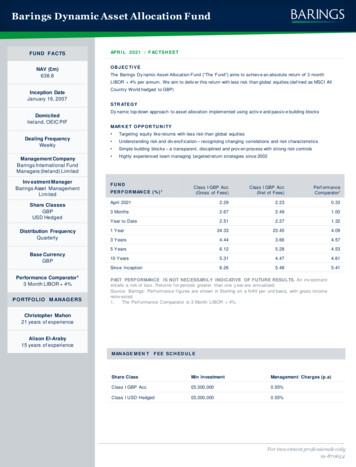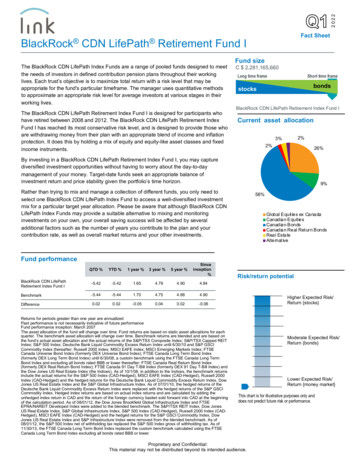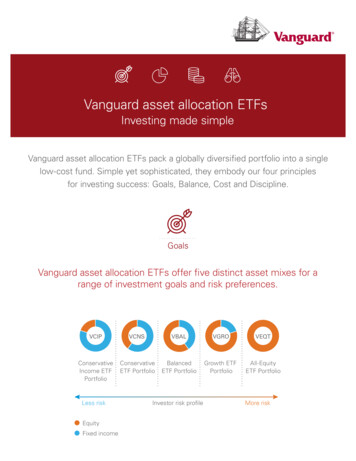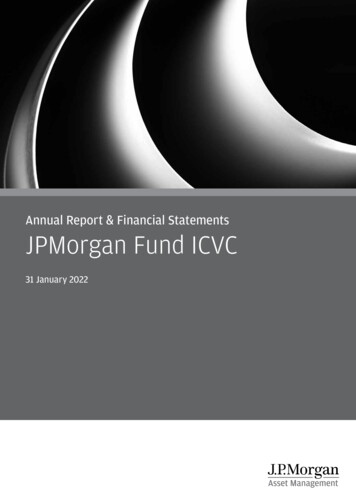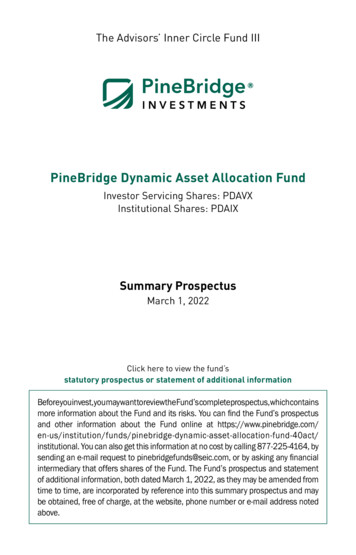
Transcription
The Advisors’ Inner Circle Fund IIIPineBridge Dynamic Asset Allocation FundInvestor Servicing Shares: PDAVXInstitutional Shares: PDAIXSummary ProspectusMarch 1, 2022Click here to view the fund’sstatutory prospectus or statement of additional nd’scompleteprospectus,whichcontainsmore information about the Fund and its risks. You can find the Fund’s prospectusand other information about the Fund online at stitutional. You can also get this information at no cost by calling 877-225-4164, bysending an e-mail request to pinebridgefunds@seic.com, or by asking any financialintermediary that offers shares of the Fund. The Fund’s prospectus and statementof additional information, both dated March 1, 2022, as they may be amended fromtime to time, are incorporated by reference into this summary prospectus and maybe obtained, free of charge, at the website, phone number or e-mail address notedabove.
Investment ObjectiveThe PineBridge Dynamic Asset Allocation Fund (the “Fund”) seeks totalreturn.Fund Fees and ExpensesThis table describes the fees and expenses that you may pay if you buyand hold Investor Servicing Shares and Institutional Shares of the Fund.Annual Fund Operating Expenses (expenses that you pay each year as apercentage of the value of your aresManagement Fees0.75%0.75%Other Expenses0.30%0.36%Shareholder Servicing FeeNone0.06%Other Operating Expenses0.30%0.30%Total Annual Fund Operating Expenses1.05%1.11%Less Fee Reductions and/or Expense Reimbursements1(0.30)%(0.30)%Total Annual Fund Operating Expenses After FeeReductions and/or Expense Reimbursements0.75%0.81%PineBridge Investments LLC (the “Adviser”) has contractually agreed to waive fees and/or to reimburse expenses tothe extent necessary to keep Total Annual Fund Operating Expenses (excluding interest, taxes, brokerage commissionsand other costs and expenses relating to the securities that are purchased and sold by the Fund, dividend and interestexpenses on securities sold short, Shareholder Servicing Fees, acquired fund fees and expenses, other expenditureswhich are capitalized in accordance with generally accepted accounting principles, and non-routine expenses(collectively, “excluded expenses”)) from exceeding 0.75% of the average daily net assets of the Fund’s InstitutionalShares and Investor Servicing Shares until April 30, 2023. The Adviser may receive from the Fund the differencebetween the Total Annual Fund Operating Expenses (not including excluded expenses) and the contractual expenselimit to recoup all or a portion of its prior fee waivers or expense reimbursements made during the rolling threeyear period preceding the recoupment if at any point Total Annual Fund Operating Expenses (not including excludedexpenses) are below the contractual expense limit (i) at the time of the fee waiver and/or expense reimbursement and(ii) at the time of the recoupment. This agreement may be terminated: (i) by the Board of Trustees (the “Board”) of TheAdvisors’ Inner Circle Fund III (the “Trust”), for any reason at any time; or (ii) by the Adviser, upon ninety (90) days’ priorwritten notice to the Trust, effective as of the close of business on April 30, 2023.ExampleThis Example is intended to help you compare the cost of investing in theFund with the cost of investing in other mutual funds.2
The Example assumes that you invest 10,000 in the Fund for the timeperiods indicated and then redeem all of your shares at the end of thoseperiods. The Example also assumes that your investment has a 5% returneach year and that the Fund’s operating expenses (including cappedexpenses for the period described in the footnote to the fee table) remainthe same. Although your actual costs may be higher or lower, based onthese assumptions your costs would be:Institutional SharesInvestor Servicing Shares1 Year3 Years5 Years10 Years 77 83 304 323 550 583 1,255 1,325Portfolio TurnoverThe Fund pays transaction costs, such as commissions, when it buys andsells securities (or “turns over” its portfolio). A higher portfolio turnover ratemay indicate higher transaction costs and may result in higher taxes whenFund shares are held in a taxable account. These costs, which are notreflected in total annual Fund operating expenses or in the example, affectthe Fund’s performance. During its most recent fiscal year, the Fund’sportfolio turnover rate was 130% of the average value of its portfolio.Principal Investment StrategiesThe investment objective of the Fund is to seek to achieve total returnprimarily by managing allocations among a broad range of asset classes,and secondarily by generating alpha (i.e., excess returns) throughindividual investment selections, based on a combination of factors,including, but not limited to, the Adviser’s macroeconomic views,fundamental analyses and risk management considerations.In seeking to manage its exposure to asset classes and individualinvestments, the Fund may take long and short positions directly, orindirectly through pooled investment vehicles (such as open-end funds,closed-end funds, exchange-traded funds (“ETFs”), unregistered funds(e.g., hedge funds), and real estate investment trusts (“REITs”), advisedby the Adviser or its affiliates, or other investment advisers), in equityand debt securities, derivative instruments, cash and other moneymarket instruments. The Fund will not purchase an investment if, as aresult, more than 15% of the value of the Fund’s net assets would beinvested in unregistered funds, except as specifically permitted underthe Investment Company Act of 1940, as amended (the “1940 Act”), the3
rules and regulations thereunder or any exemption therefrom, as suchstatute, rules or regulations may be amended or interpreted from timeto time.The equity securities in which the Fund principally invests may includecommon and preferred stocks, convertible securities, rights andwarrants, and depositary receipts (including American DepositaryReceipts (“ADRs”), European Depositary Receipts (“EDRs”) and GlobalDepositary Receipts (“GDRs”)). The Fund may invest in equity securitiesof companies of any market capitalization. The fixed income securitiesin which the Fund principally invests may include securities issued orguaranteed by the U.S. government and its agencies or instrumentalities,foreign sovereign debt, corporate obligations, residential and commercialmortgage-backed securities, asset-backed securities, collateralized debtobligations (including collateralized loan obligations and collateralizedbond obligations), bank loans (through both assignments andparticipations) and bank obligations. The Fund may invest in fixed incomesecurities of any maturity, duration or credit quality, including those thatare rated below investment grade (“high yield” or “junk” bonds). The Fundmay also enter into repurchase and reverse repurchase agreements, andengage in securities lending. The derivative instruments in which theFund invests may be exchange-traded or over-the-counter (“OTC”), andinclude futures contracts, forward contracts, options and swaps, relatingto securities, currencies, or other instruments, entered into for hedgingor speculative purposes, or to manage cash flows. The Fund investsin U.S. and non-U.S. (including both developed and emerging market)companies, countries and currencies. The Fund may invest in A-Shares ofcompanies based in the People’s Republic of China (“China”) that tradeon the Shanghai Stock Exchange and the Shenzhen Stock Exchangethrough the Shanghai – Hong Kong and Shenzhen – Hong Kong StockConnect programs (“Stock Connect”). Stock Connect is a mutual stockmarket access program designed to, among other things, enable foreigninvestments in China. The Fund may invest in the domestic bond marketin China through China’s Bond Connect Program (“Bond Connect”), aprogram that provides foreign investors with access to China’s onshorebond market.When the Adviser believes that market conditions are unfavorable forprofitable investing, or is otherwise unable to locate attractive investmentopportunities, it may increase the Fund’s investments in cash or moneymarket instruments (such as short-term U.S. government, corporate, andbank obligations, and money market funds) to protect the Fund’s assets4
and maintain liquidity. The Fund may adjust its asset allocations at anytime, and may buy and sell investments frequently, particularly duringperiods of increased market volatility.Principal RisksAs with all mutual funds, there is no guarantee that the Fund will achieveits investment objective. You could lose money by investing in the Fund. AFund share is not a bank deposit and is not insured or guaranteed by the FederalDeposit Insurance Corporation (“FDIC”) or any other government agency. Theprincipal risk factors affecting shareholders’ investments in the Fund areset forth below.Asset Allocation Risk — The Fund is subject to asset allocation risk, which isthe risk that the Adviser’s allocation of the Fund’s assets among variousasset classes will cause the Fund to underperform other funds with asimilar investment objective and/or underperform the markets in whichthe Fund invests.Equity Risk — Since it purchases equity securities, the Fund is subject tothe risk that stock prices may fall over short or extended periods of time.Historically, the equity market has moved in cycles, and the value of theFund’s securities may fluctuate from day to day. Individual companiesmay report poor results or be negatively affected by industry and/oreconomic trends and developments. The prices of securities issued bysuch companies may suffer a decline in response.Small- and Mid-Capitalization Company Risk — Small- and mid-capitalizationcompanies may be more vulnerable to adverse business or economicevents than larger, more established companies. In particular, investmentsin these small- and mid-sized companies may pose additional risks,including liquidity risk, because these companies tend to have limitedproduct lines, markets and financial resources, and may depend upon arelatively small management group. Therefore, small- and mid-cap stocksmay be more volatile than those of larger companies. These securitiesmay be traded over-the-counter or listed on an exchange.Foreign Company Risk — Investing in foreign companies, including directinvestments and investments through depositary receipts, posesadditional risks since political and economic events unique to a countryor region will affect those markets and their issuers. These risks willnot necessarily affect the U.S. economy or similar issuers located in theU.S. Securities of foreign companies may not be registered with the U.S.Securities and Exchange Commission (the “SEC”) and foreign companiesare generally not subject to the regulatory controls imposed on U.S.5
issuers and, as a consequence, there is generally less publically availableinformation about foreign securities than is available about domesticsecurities. Income from foreign securities owned by the Fund may bereduced by a withholding tax at the source, which tax would reduceincome received from the securities comprising the Fund’s portfolio.Foreign securities may also be more difficult to value than securitiesof U.S. issuers. In addition, periodic U.S. Government restrictions oninvestments in issuers from certain foreign countries may require theFund to sell such investments at inopportune times, which could resultin losses to the Fund. While depositary receipts provide an alternative todirectly purchasing the underlying foreign securities in their respectivenational markets and currencies, investments in depositary receiptscontinue to be subject to many of the risks associated with investingdirectly in foreign securities.Emerging Markets Securities Risk — The Fund’s investments in emergingmarkets securities are considered speculative and subject to heightenedrisks in addition to the general risks of investing in foreign securities. Unlikemore established markets, emerging markets may have governmentsthat are less stable, markets that are less liquid and economies that areless developed. In addition, the securities markets of emerging marketcountries may consist of companies with smaller market capitalizationsand may suffer periods of relative illiquidity; significant price volatility;restrictions on foreign investment; and possible restrictions onrepatriation of investment income and capital. Furthermore, foreigninvestors may be required to register the proceeds of sales, and futureeconomic or political crises could lead to price controls, forced mergers,expropriation or confiscatory taxation, seizure, nationalization or creationof government monopolies.Stock Connect Investing Risk — Trading through Stock Connect is subjectto a number of restrictions that may affect the Fund’s investments andreturns, including a daily quota that limits the maximum net purchasesunder Stock Connect each day. In addition, investments made throughStock Connect are subject to relatively untested trading, clearance andsettlement procedures. Moreover, A-Shares purchased through StockConnect generally may only be sold or otherwise transferred throughStock Connect. The Fund’s investments in A-Shares purchased throughStock Connect are generally subject to Chinese securities regulations andlisting rules. While overseas investors currently are exempt from payingcapital gains or value added taxes on income and gains from investmentsin A-Shares purchased through Stock Connect, these tax rules could bechanged, which could result in unexpected tax liabilities for the Fund.Stock Connect operates only on days when both the China and Hong6
Kong markets are open for trading and when banks in both markets areopen on the corresponding settlement days. Therefore, the Fund may besubject to the risk of price fluctuations of A-Shares when Stock Connectis not trading.Bond Connect Risk — Trading through Bond Connect is subject to a numberof restrictions that may affect the Fund’s investments and returns.Investments made through Bond Connect are subject to order, clearanceand settlement procedures that are relatively untested in China, whichcould pose risks to the Fund. Furthermore, securities purchased via BondConnect will be held via a book entry omnibus account in the name ofthe Hong Kong Monetary Authority Central Money Markets Unit (“CMU”)maintained with a China-based custodian (either the China CentralDepository & Clearing Co. (“CDCC”) or the Shanghai Clearing House(“SCH”)). The Fund’s ownership interest in Bond Connect securitieswill not be reflected directly in book entry with CDCC or SCH and willinstead only be reflected on the books of its Hong Kong sub-custodian.Therefore, the Fund’s ability to enforce rights as a bondholder maydepend on CMU’s ability or willingness as record-holder of Bond Connectsecurities to enforce the Fund’s rights as a bondholder. Additionally, theomnibus manner in which the securities are held could expose the Fundto the risk of its Hong Kong sub-custodian. While the ultimate investorshold a beneficial interest in Bond Connect securities, the mechanismsthat beneficial owners may use to enforce their rights are untested. Inaddition, courts in China have limited experience in applying the conceptof beneficial ownership. Moreover, securities purchased through BondConnect generally may not be sold, purchased or otherwise transferredother than through Bond Connect in accordance with applicable rules.Risks of Investing in Other Investment Companies — To the extent the Fundinvests in other investment companies, such as open-end funds, closedend funds and ETFs, the Fund will be subject to substantially the samerisks as those associated with the direct ownership of the securitiesheld by such other investment companies. As a shareholder of anotherinvestment company, the Fund relies on that investment companyto achieve its investment objective. If the investment company fails toachieve its objective, the value of the Fund’s investment could decline,which could adversely affect the Fund’s performance. By investingin another investment company, Fund shareholders indirectly bearthe Fund’s proportionate share of the fees and expenses of the otherinvestment company, in addition to the fees and expenses that Fundshareholders directly bear in connection with the Fund’s own operations.7
Because ETFs and certain closed-end funds are listed on national stockexchanges and are traded like stocks listed on an exchange, their sharespotentially may trade at a discount or premium. Investments in ETFs andcertain closed-end funds are also subject to brokerage and other tradingcosts, which could result in greater expenses to the Fund. In addition,because the value of ETF and certain closed-end fund shares dependson the demand in the market, the Adviser may not be able to liquidate theFund’s holdings at the most optimal time, which could adversely affectFund performance.Derivatives Risk — The Fund’s use of futures contracts, forward contracts,options and swaps is subject to market risk, leverage risk, correlation risk,liquidity risk and hedging risk. Market risk is described elsewhere in thissection. Leverage risk is the risk that since derivatives may be purchasedfor a fraction of their value, a relatively small price movement in a derivativemay result in an immediate and substantial loss or gain for the Fund, andmay also cause the Fund to liquidate portfolio positions when it would notbe advantageous to do so in order to satisfy its obligations. Correlationrisk is the risk that changes in the value of the derivative may not correlateperfectly or at all with the underlying asset, rate or index. Liquidity risk isthe risk that certain securities may be difficult or impossible to sell atthe time and the price that the Fund would like. Hedging risk is the riskthat derivative instruments used for hedging purposes may also limit anypotential gain that may result from the increase in value of the hedgedasset. To the extent that the Fund engages in hedging strategies, therecan be no assurance that such strategy will be effective or that there willbe a hedge in place at any given time. The Fund’s use of forwards andswaps is also subject to credit risk and valuation risk. Credit risk is therisk that the counterparty to a derivative contract will default or otherwisebecome unable to honor a financial obligation. Valuation risk is the riskthat a security may be difficult to value. Each of these risks could causethe Fund to lose more than the principal amount invested in a derivativeinstrument.Foreign Currency Risk — As a result of the Fund’s investments in securitiesdenominated in, and/or receiving revenues in, foreign currencies, theFund will be subject to currency risk. Currency risk is the risk that foreigncurrencies will decline in value relative to the U.S. dollar, in which case,the dollar value of an investment in the Fund would be adversely affected.Market Risk — The prices of and the income generated by the Fund’ssecurities may decline in response to, among other things, investorsentiment, general economic and market conditions, regional or globalinstability, and currency and interest rate fluctuations. In addition, theimpact of any epidemic, pandemic or natural disaster, or widespread fear8
that such events may occur, could negatively affect the global economy, aswell as the economies of individual countries, the financial performanceof individual companies and sectors, and the markets in general insignificant and unforeseen ways. Any such impact could adverselyaffect the prices and liquidity of the securities and other instruments inwhich the Fund invests, which in turn could negatively impact the Fund’sperformance and cause losses on your investment in the Fund.REITs Risk — REITs are pooled investment vehicles that own, and usuallyoperate, income-producing real estate. REITs are susceptible to the risksassociated with direct ownership of real estate, such as the following:declines in property values; increases in property taxes, operatingexpenses, interest rates or competition; overbuilding; zoning changes;and losses from casualty or condemnation. REITs typically incur fees thatare separate from those of the Fund. Accordingly, the Fund’s investmentsin REITs will result in the layering of expenses such that shareholders willindirectly bear a proportionate share of the REITs’ operating expenses,in addition to paying Fund expenses. REIT operating expenses are notreflected in the fee table and example in this prospectus.Short Sales Risk — A short sale involves the sale of a security that theFund does not own in the expectation of purchasing the same security(or a security exchangeable therefore) at a later date at a lower price.Short sales expose the Fund to the risk that it will be required to buythe security sold short (also known as “covering” the short position) ata time when the security has appreciated in value, thus resulting in aloss to the Fund. Investment in short sales may also cause the Fund toincur expenses related to borrowing securities. Reinvesting proceedsreceived from short selling may create leverage which can amplify theeffects of market volatility on the Fund and, therefore, the Fund’s shareprice. Theoretically, uncovered short sales have the potential to exposethe Fund to unlimited losses.Convertible Securities Risk — The value of a convertible security isinfluenced by changes in interest rates (with investment value decliningas interest rates increase and increasing as interest rates decline) andthe credit standing of the issuer. The price of a convertible security willalso normally vary in some proportion to changes in the price of theunderlying common stock because of the conversion or exercise feature.Rights and Warrants Risk — Investments in rights or warrants involvethe risk of loss of the purchase value of a right or warrant if the rightto subscribe to additional shares is not exercised prior to the right’s orwarrant’s expiration. Also, the purchase of rights and/or warrants involvesthe risk that the effective price paid for the right and/or warrant added to9
the subscription price of the underlying security may exceed the marketprice of the underlying security in instances such as those where there isno movement in the price of the underlying security.Preferred Stocks Risk — Preferred stocks are sensitive to interest ratechanges, and are also subject to equity risk, which is the risk that stockprices will fall over short or extended periods of time. The rights ofpreferred stocks on the distribution of a company’s assets in the eventof a liquidation are generally subordinate to the rights associated with acompany’s debt securities.Credit Risk — The credit rating or financial condition of an issuer mayaffect the value of a fixed income security. Generally, the lower the creditquality of a security, the greater the perceived risk that the issuer will failto pay interest fully and return principal in a timely manner. If an issuerdefaults or becomes unable to honor its financial obligations, the securitymay lose some or all of its value.Bank Loans Risk — Investments in bank loans (through both assignmentsand participations) are generally subject to the same risks as investmentsin other types of debt instruments, including, in many cases, investmentsin junk bonds. There may be limited public information available regardingbank loans and bank loans may be difficult to value. If the Fund holds abank loan through another financial institution, or relies on a financialinstitution to administer the loan, its receipt of principal and interest onthe loan may be subject to the credit risk of that financial institution.It is possible that any collateral securing a loan may be insufficient orunavailable to the Fund, and that the Fund’s rights to collateral maybe limited by bankruptcy or insolvency laws. In addition, the secondarymarket for bank loans may be subject to irregular trading activity, widebid/ask spreads, and extended trade settlement periods, which maycause the Fund to be unable to realize the full value of its investment ina bank loan.Bank loans may not be considered “securities,” and purchasers, suchas the Fund, therefore may not be entitled to rely on the anti-fraudprotections of the federal securities laws.High Yield Bond Risk — High yield, or “junk,” bonds are debt securities ratedbelow investment grade. High yield bonds are speculative, involve greaterrisks of default, downgrade, or price declines and are more volatile andtend to be less liquid than investment-grade securities. Companies issuinghigh yield bonds are less financially strong, are more likely to encounterfinancial difficulties, and are more vulnerable to adverse market eventsand negative sentiments than companies with higher credit ratings.10
Collateralized Debt Obligations Risk — The risks of an investment in acollateralized debt obligation depend largely on the type of the collateralsecurities and the class of the debt obligation in which the Fund invests.Collateralized debt obligations are generally subject to credit, interestrate, prepayment and extension, valuation and liquidity risks, which aredescribed elsewhere in this section. These securities also are subjectto risk of default on the underlying assets, particularly during periods ofeconomic downturn.Collateralized Loan Obligation Risk. The risks of an investment ina collateralized loan obligation depend largely on the type of thecollateral securities and the class of the debt obligation in which theFund invests. Collateralized loan obligations are generally subjectto credit, interest rate, prepayment and extension, valuation andliquidity risks, which are described elsewhere in this section. Thesesecurities also are subject to risk of default on the underlying asset,particularly during periods of economic downturn.Collateralized loan obligations carry additional risks including, butnot limited to, (i) the possibility that distributions from collateralsecurities will not be adequate to make interest of other payments,(ii) the collateral may decline in value or default, (iii) the Fund mayinvest in obligations that are subordinate to other classes, and (iv)the complex structure of the security may not be fully understoodat the time of investment and produce disputes with the issuer orunexpected investment results.Collateralized Bond Obligation Risk. The pool of high yield securitiesunderlying collateralized bond obligations is typically separatedinto groupings called tranches representing different degrees ofcredit quality. The higher quality tranches have greater degrees ofprotection and pay lower interest rates. The lower tranches, withgreater risk, pay higher interest rates.Corporate Fixed Income Securities Risk — Corporate fixed income securitiesrespond to economic developments, especially changes in interest rates,as well as perceptions of the creditworthiness and business prospects ofindividual issuers.Foreign Sovereign Debt Securities Risk — The Fund’s investments in foreignsovereign debt securities are subject to the risks that: (i) the governmentalentity that controls the repayment of sovereign debt may not be willingor able to repay the principal and/or interest when it becomes due,due to factors such as debt service burden, political constraints, cashflow problems and other national economic factors; (ii) governmentsmay default on their debt securities, which may require holders of such11
securities to participate in debt rescheduling or additional lending todefaulting governments; and (iii) there is no bankruptcy proceeding bywhich defaulted sovereign debt may be collected in whole or in part.Mortgage-Backed Securities Risk — Mortgage-backed securities areaffected by, among other things, interest rate changes and the possibilityof prepayment of the underlying mortgage loans. Mortgage-backedsecurities are also subject to the risk that underlying borrowers will beunable to meet their obligations.Asset-Backed Securities Risk — Payment of principal and interest on assetbacked securities is dependent largely on the cash flows generated bythe assets backing the securities, and asset-backed securities may nothave the benefit of any security interest in the related assets.Bank Obligations Risk — The Fund’s investments in bank obligations aresubject to risks generally applicable to debt securities, as well as to the riskof negative events affecting the banking industry. Obligations of foreignbanks and foreign branches of U.S. banks are subject to additional risks,including negative political and economic developments in the country inwhich the bank or branch is located and actions by a foreign governmentthat might adversely affect the payment of principal and interest on suchobligations, such as the seizure or nationalization of foreign deposits.Additionally, U.S. and state banking laws and regulations may not applyto foreign branches of U.S. banks, and generally do not apply to foreignbanks.Prepayment and Extension Risk — When interest rates fall, issuers of highinterest debt obligations may pay off the debts earlier than expected(prepayment risk), and the Fund may have to reinvest the proceedsat lower yields. When interest rates rise, issuers of lower interest debtobligations may pay off the debts later than expected (extension risk),thus keeping the Fund’s assets tied up in lower interest debt obligations.Portfolio Turnover Risk — The Fund is subject to portfolio turnover risk sinceit may buy and sell investments frequently. Such a strategy often involveshigher expenses, including brokerage commissions, and may increasethe amount of capital gains (in particular, short term gains) realized byt
Fund share is not a bank deposit and is not insured or guaranteed by the Federal Deposit Insurance Corporation ("FDIC") or any other government agency. The principal risk factors affecting shareholders' investments in the Fund are set forth below. Asset Allocation Risk — The Fund is subject to asset allocation risk, which is
![[Title to come] DSP Dynamic Asset Allocation Fund](/img/24/dsp-dynamic-asset-allocation-fund.jpg)

